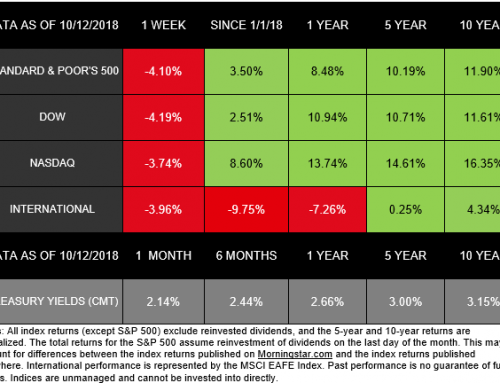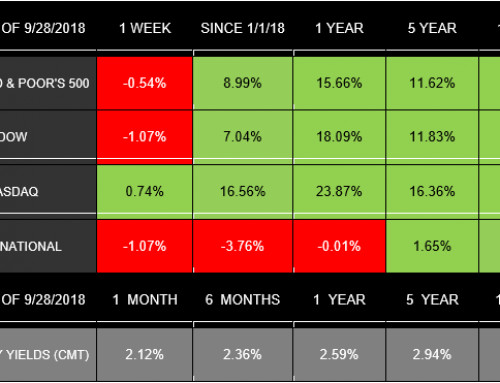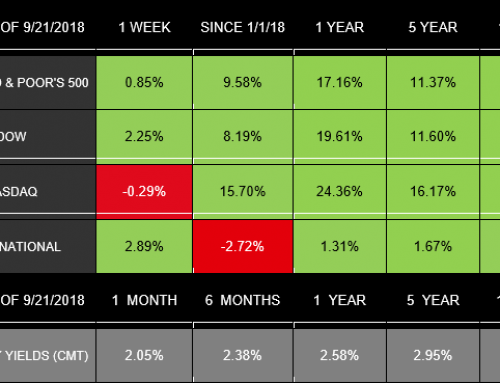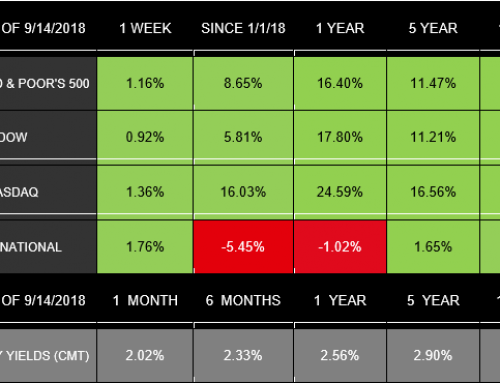U.S. markets were up again last week, as major domestic indexes posted their 4th weekly gains in a row.[i] In fact, the S&P 500 was no longer in correction territory at Friday’s close—and was in the middle of its best yearly start since 1987.[ii]
For the week, the S&P 500 gained 2.87%, the Dow added 2.96%, and the NASDAQ increased by 2.66%. So far, all three indexes are up more than 5% in 2019.[iii] Internationally, the MSCI EAFE also ended the week in positive territory, posting a 1.06% gain.[iv]
What is driving the rally?
Once again, developments in our ongoing trade negotiations with China contributed to the performance. On Thursday, a report emerged that the U.S. was weighing whether to lift tariffs on Chinese imports. However, the Treasury Department said Secretary Steve Mnuchin had not recommended this action.[v] Then, on Friday, Bloomberg released news that China may raise its imports to a level that would close the trade deficit by 2024.[vi] This potential sign of progress contributed to the day’s market gains.[vii]
While these trade updates significantly affected stock performance last week, the following details are also worth noting:
- Corporate earnings season started.
So far, 11% of S&P 500 companies have released their earnings reports for the 4th quarter of 2018. As expected, growth is not as fast as in the last year’s previous quarters, but total earnings are still up 16.9% over the same period in 2017. We are very early in earnings season but anticipate data from another 56 companies coming out this week.[viii]
- Consumer sentiment missed expectations.
The latest consumer sentiment reading fell to its lowest level since 2016, yet it still remains relatively high. This decline could signal that the current impasse over border-wall funding and the volatile markets are negatively affecting the economy.[ix]
- Manufacturing beat projections.
The latest data showed that U.S. manufacturing output increased by 1.1% in December. This rate exceeded expectations and may help calm concerns that factory production is slowing.[x]
- The government shutdown continued.
Since December 22, parts of the Federal government have been closed, marking the longest shutdown in U.S. history. Economists estimate that each week the shutdown continues could reduce our quarterly growth of Gross Domestic Product by up to 0.2%.[xi]
Looking ahead, we will not only have earnings data to consider in this shortened trading week, but also information on home sales and durable goods orders. We’ll continue to monitor economic reports—and geopolitical developments—as we support each client’s long-term goals. As always, if you have questions or concerns, we’re here for you.
ECONOMIC CALENDAR
Monday: Markets Closed for Martin Luther King Jr. Day
Tuesday: Existing Home Sales
Thursday: Jobless Claims
Friday: Durable Goods Orders, New Home Sales
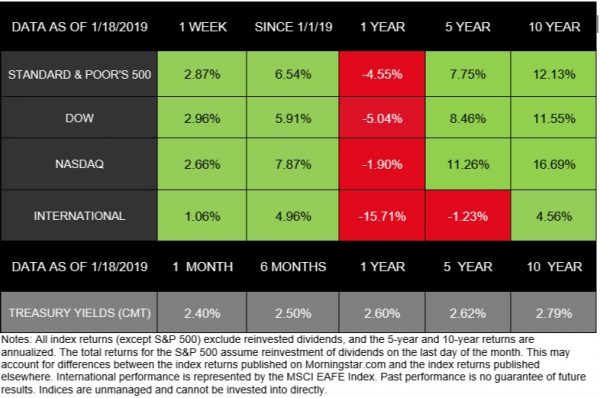
Investing involves risk including the potential loss of principal. No investment strategy can guarantee a profit or protect against loss in periods of declining values.
Diversification does not guarantee profit nor is it guaranteed to protect assets.
International investing involves special risks such as currency fluctuation and political instability and may not be suitable for all investors.
The Standard & Poor’s 500 (S&P 500) is an unmanaged group of securities considered to be representative of the stock market in general.
The Dow Jones Industrial Average is a price-weighted average of 30 significant stocks traded on the New York Stock Exchange and the NASDAQ. The DJIA was invented by Charles Dow back in 1896.
The Nasdaq Composite is an index of the common stocks and similar securities listed on the NASDAQ stock market and is considered a broad indicator of the performance of stocks of technology companies and growth companies.
The MSCI EAFE Index was created by Morgan Stanley Capital International (MSCI) that serves as a benchmark of the performance in major international equity markets as represented by 21 major MSCI indices from Europe, Australia, and Southeast Asia.
The 10-year Treasury Note represents debt owed by the United States Treasury to the public. Since the U.S. Government is seen as a risk-COMPLIMENTARY borrower, investors use the 10-year Treasury Note as a benchmark for the long-term bond market.
Opinions expressed are subject to change without notice and are not intended as investment advice or to predict future performance.
Past performance does not guarantee future results.
You cannot invest directly in an index.
Consult your financial professional before making any investment decision.
Fixed income investments are subject to various risks including changes in interest rates, credit quality, inflation risk, market valuations, prepayments, corporate events, tax ramifications and other factors.
These are the views of Platinum Advisor Strategies, LLC, and not necessarily those of the named representative,
Broker dealer or Investment Advisor and should not be construed as investment advice. Neither the named representative nor the named Broker dealer or Investment Advisor gives tax or legal advice. All information is believed to be from reliable sources; however, we make no representation as to its completeness or accuracy. Please consult your financial advisor for further information.
By clicking on these links, you will leave our server, as the links are located on another server. We have not independently verified the information available through this link. The link is provided to you as a matter of interest. Please click on the links below to leave and proceed to the selected site.
[ii] https://www.cnbc.com/2019/01/18/stocks-us-china-trade-talks-take-center-stage-shutdown-earnings.html
http://performance.morningstar.com/Performance/index-c/performance-return.action?t=@CCO
[iv] https://www.msci.com/end-of-day-data-search
[vii] https://www.cnbc.com/2019/01/18/stocks-us-china-trade-talks-take-center-stage-shutdown-earnings.html
[viii] https://www.nasdaq.com/article/key-takeaways-from-q4-earnings-results-thus-far-cm1084343
[x] https://www.cnbc.com/2019/01/18/industrial-production-december-2018.html

